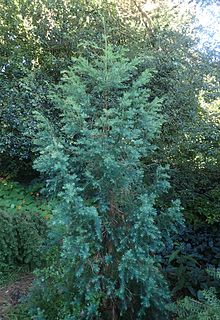Cypress is a common name for various coniferous trees or shrubs of northern temperate regions that belong to the family Cupressaceae. The word cypress is derived from Old French cipres, which was imported from Latin cypressus, the latinisation of the Greek κυπάρισσος (kyparissos). Cypress trees are a large classification of conifers, encompassing the trees and shrubs from the cypress family (Cupressaceae) and many others with the word cypress in their common name. Many cypress trees have needle-like, evergreen foliage and acorn-like seed cones.

Chamaecyparis pisifera is a species of false cypress, native to central and southern Japan, on the islands of Honshū and Kyūshū.

Cupressus arizonica, the Arizona cypress, is a North American species of tree in the cypress family Cupressaceae, native to the southwestern United States and Mexico. Populations may be scattered rather than in large, dense stands.

Glyptostrobus pensilis, known in Chinese as 水松, and also Chinese swamp cypress, is an endangered conifer, and the sole living species in the genus Glyptostrobus.

Cupressus bakeri, reclassified as Hesperocyparis bakeri, with the common names Baker cypress, Modoc cypress, or Siskiyou cypress, is a rare species of cypress tree endemic to a small area across far northern California and extreme southwestern Oregon, in the western United States.
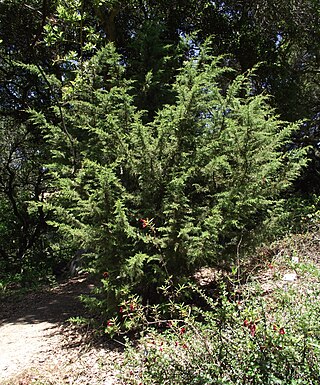
Cupressus goveniana, now reclassified as Hesperocyparis goveniana, with the common names Californian cypress and Gowen cypress, is a species of cypress, that is endemic to California.

Cupressus guadalupensis, the Guadalupe cypress, is a species of cypress from Guadalupe Island in the Pacific Ocean off western North America.

Cupressus lusitanica, the Mexican cedar or cedar-of-Goa, is a species of cypress native to Mexico and Central America. It has also been introduced to Belize, Costa Rica and Nicaragua, growing at 1,200–3,000 metres (3,900–9,800 ft) altitude.

Cupressus funebris, the Chinese weeping cypress, is a species of cypress native to southwestern and central China. It may also occur naturally in Vietnam.
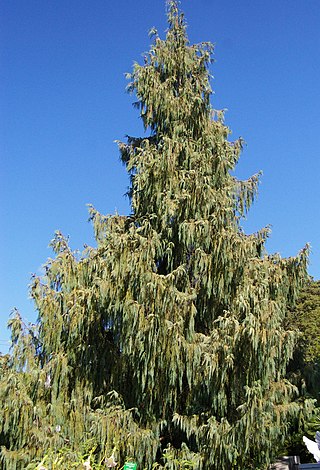
Cupressus cashmeriana, the Bhutan cypress or Kashmir cypress, is a species of evergreen conifer native to the eastern Himalaya in Bhutan and adjacent areas of Arunachal Pradesh in northeastern India. [ Now in vulnerable category, IUCN list retrieved in 2006 ]. It is also introduced in China and Nepal. It grows at moderately high altitudes of 1,250–2,800 metres (4,100–9,190 ft).
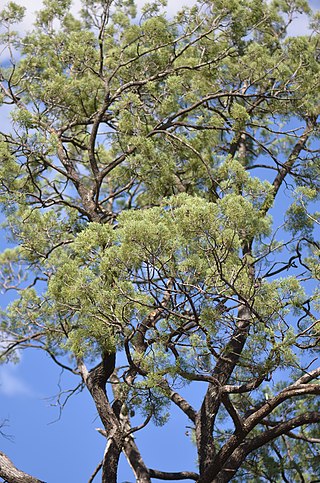
Callitris columellaris is a species of coniferous tree in the family Cupressaceae, native to most of Australia. Common names include white cypress, white cypress-pine, Murray River cypress-pine, and northern cypress-pine. Callitris columellaris has become naturalised in Hawaii and in southern Florida.
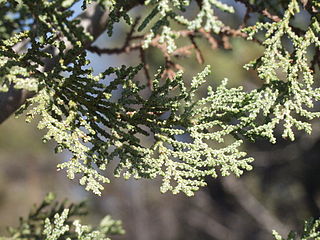
Cupressus macnabiana is a species of cypress in western North America.
Callitris roei, or Roe's cypress-pine, is a species of Callitris native to Australia, where it is endemic to southwestern Western Australia from Moora south to Albany and east to Cape Arid National Park.

Chamaecyparis formosensis is a species of Chamaecyparis, endemic to Taiwan, where it grows in the central mountains at moderate to high altitudes of 1000–2900 m. It is threatened by habitat loss and over-cutting for its valuable timber.

Libocedrus bidwillii, also called pāhautea, kaikawaka or New Zealand cedar, is a species of Libocedrus, endemic to New Zealand. It is in the cypress family Cupressaceae.

Libocedrus plumosa, with the common name kawaka, is a species of Libocedrus that is endemic to New Zealand.

Widdringtonia wallichii, Clanwilliam cedar or Clanwilliam cypress, previously Widdringtonia cedarbergensis is a species of Widdringtonia native to South Africa, where it is endemic to the Cederberg Mountains northeast of Cape Town in Western Cape Province. It is threatened by habitat loss and protected in South Africa under the National Forest Act of 1998.
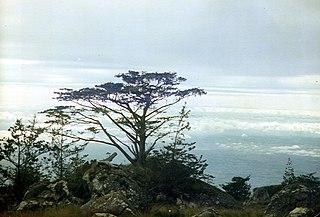
Widdringtonia whytei, the Mulanje cedar or Mulanje cypress, is a species of conifer native to Malawi, where it is endemic to the Mulanje Massif at altitudes of 1,830–2,550 m. It has become endangered as a result of over-harvesting for its wood, and an increase in the frequency of wildfires due to human activity.

Widdringtonia nodiflora is a species of Widdringtonia native to Southern Africa. It usually grows at high altitudes, typically among rocks on mountainsides. Its foliage and wood are highly flammable while its natural habitat is prone to fire. To compensate, the species will coppice from its roots after being burnt down.

Cupressus nevadensis, now reclassified as Hesperocyparis nevadensis, with the common name Paiute cypress, is a species of cypress tree native to a small area in Sierra Nevada of California, in the western United States.
